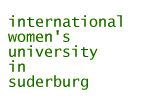| |
Photography project, 2 weeks, September 7th to September 14th, 2000
Artist: Eugenia Vargas
Assistant: Claudia Tribin
Tutor: Christine Kriegerowski
Eugenia Vargas is a Miami-based artist, who is originally from Chile.
As a photographer, she tries to both show environmental damage through photography and to
consider the environmental damage done by photo chemicals.
The project lasted two weeks and ended with a performance that had been planned by Mrs. Vargas and the seven participants.
Mrs. Vargas introduced her work to give the participants an idea of her work and concern with the environment.
A timetable was made and participants collected photographic impressions of Suderburg rivers and brooks.
For three days we were able to go to Lüneburg (50 km distance from Suderburg) by bus to use a darkroom at the Fachhochschule (college).
This was a new and very interesting experience for the participants. Everybody learned to develop their films and process prints. At the
same time, Mrs. Vargas discussed the problematic situation of wastewater produced by darkroom work.The FH Lüneburg darkroom
followed high ecological standards.
We also prepared the things we needed for the final presentation. This was to be a performance: coloring a river or brook in Suderburg
and entering the symbolically polluted water. Part of the preparations was to write a text that we sent to local administration in
order to obtain permission for this performance.
The local scientific coordinator, Mrs. Urban, supplied us with the name of the responsible person.
|
Dear Mr. Stöcker,
we would kindly like to ask you to give us permission for an art project by Mrs. Eugenia Vargas, Chile/USA.
Mrs. Vargas is a photographer who on the one hand states environmental pollution documenting it photographically, ( a very well known
work is about the river Lerma in Mexico, that is being colored red, blue or green by a color production plant, according to the daily production).
On the other hand she is conscious about the damaging effects of photography chemicals. She is trying to demonstrate this double situation
in her class at the IFU in Suderburg.
Her symbolic action dramatically illustrates this problematic interdependency: The participants of Mrs. Vargas' IFU seminar color a river,
pond or brook around Suderburg (with biologically degradable coloring), to remind of water pollution all over the world.
|
|
|
Special Request by Mrs. Eugenia Vargas:
Manoel da Silva, Brazilian poet and social activist said that the river is life. What we do with it affects the life of the people, life of the
animals, the life of the water and the life of the river.
The same can be said of the Hardau River.
A living organism that sustains the region and the life of its habitants, a living organism to be proud of, for its waters are pristine,
transparent and pure. For this reason the participants of the art workshop of project area water would like to offer a tribute to the
magnificent Hardau River by coloring its water.
The motivation to realize this action is that we should never permit for a river to become any color other than clear as the Hardau.
|
|
We received the permit just in time and Mr. Stöcker also advised us to use Uranin, a color that the Fachhochschule had anyway, that is
normally used to discover leaks in plumbing. So we not only received the permit but also saved a lot of money and trouble finding the
right color.
At the end of the first week a special activity was offered: Mrs. Rasch-Pfeiffer, a Kodak environmental speaker had come to the college
in Suderburg to discuss the impact of photography on the environment and the measures that Kodak takes to protect the environment.
This talk was attended by many IFU participants from in other (water) projects.
On Monday of the second week there were two special art activities: Barbara Loreck, the coordinator of art projects visited Suderburg to
ask participants about their experience with the interdisciplinary art and science projects. Among other topics the discussion with the
Kodak chemist was talked about because people were disappointed that she hadn't really been open or willing to admit that her
employer might contribute to environmental damage through photography.
In the evening Helen Meyer Harrison gave a lecture about her EXPO project (together with her husband Newton Harrison):
"peninsula Europe". Due to their long time engagement in environmental work within an art context, the Harrisons were very
interested into the IFU water project.
Mrs. Vargas' attitude towards art and science proved very different from the Harrisons'.
They work with scientists and in a scientific manner themselves. On the other hand, Mrs. Vargas largely relies on the artist
being a kind of outlaw person who creates or makes insights possible by her being different, maybe more poetic. We discussed
these different attitudes within an ecological context.
Another undertaking of the project, was to ask Suderburg citizens about their relationship with water. Participants recorded
answers and discussed what had been said by the citizens. Also the inhabitants of the village were invited for the performance next day.
On the last day, the color was mixed in the morning, the other projects were invited to attend the performance and come to the river
bank at the ancient laundry place.
Winnie Chang poured the Uranin into the river and it turned a day glow green. After a while Jennifer Reddig and Eugenia Vargas
entered the river to a depth of about one meter. After walking through the water for about 20 m, they stepped out again, dried off
and waited for the audience to ask questions.
|
|






